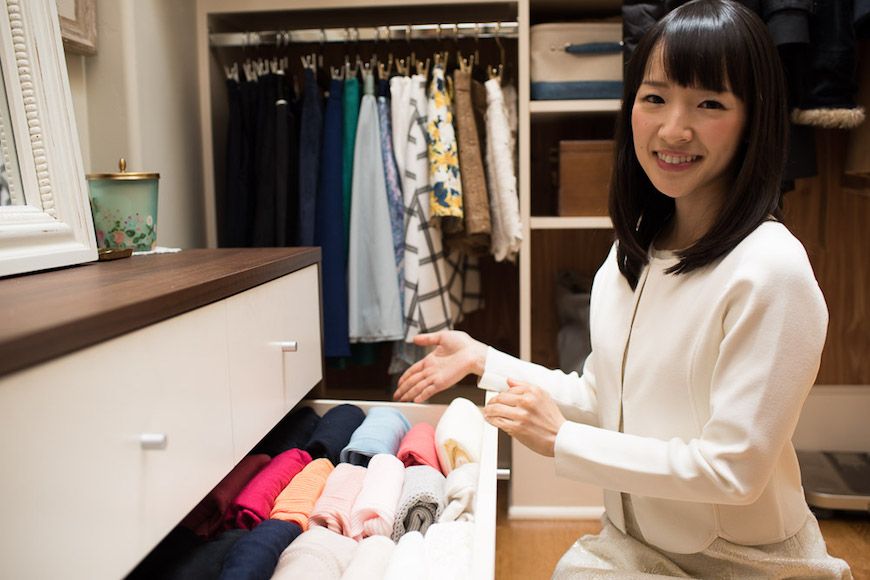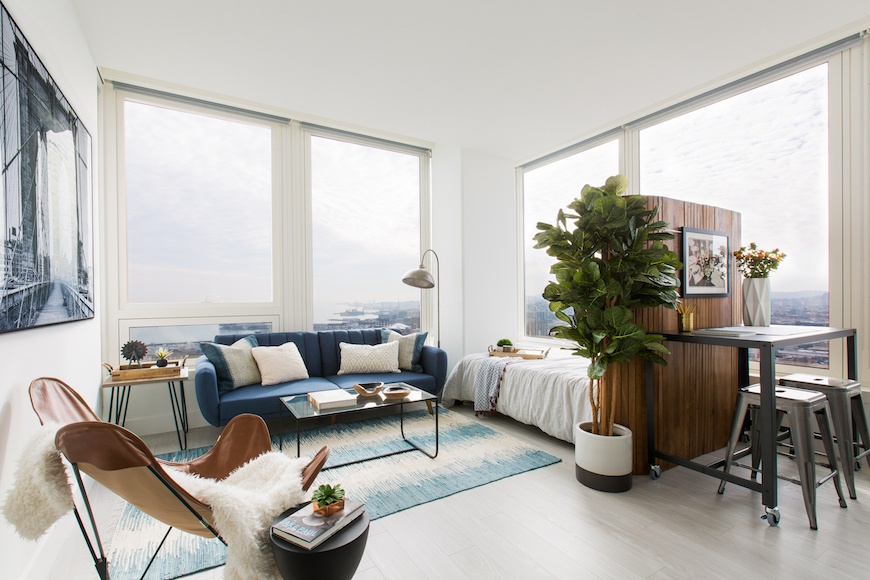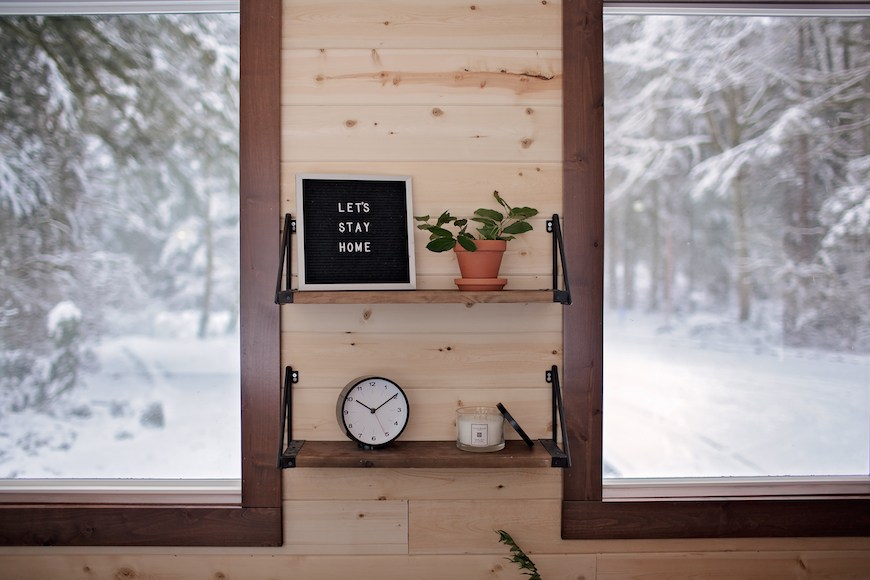The Plus Factor: Why the Obsession With Shrinking Your Life Is About More Than Tiny Spaces
A few years ago, I ran into a friend, Danielle Prescod, at Buffalo Exchange, my favorite resale mecca, who told me that she was letting go of everything that didn’t bring joy upon hugging it. I immediately began cackling at her adorable logic before she explained the now-familiar philosophy from Marie Kondo's book The Life-Changing Magic of Tidying Up. And the rest is decluttering history—but today, the sensation the book caused in 2014 is looking more like a turning point than a passing fad. Let's face it: Small is big, and getting bigger each year. But why?
“The KonMari method is not just a tidying method, but also a way to re-examine your life,” Kondo tells me of the ever-increasing number of people surveying their property and “building a lifestyle surrounded by things that truly matter to them.”
“The KonMari Method is not just a tidying method, but also a way to re-examine your life.” —Marie Kondo
Reverberating across the home, wellness, and fashion industry alike, this Kondoist world isn’t about forcing things into smaller spaces—though to be fair, Kondo has partnered with California Closets to organize even the tiniest spaces into stunningly displayed, yet perfectly functional storage—but rather imparting respect to daily essentials and showcasing beloved items in a beautiful, stylized, and stress-subduing manner. Think boutique closets, designer appliances, and “freedom-first” attitudes toward ownership in general.
As Kondo excitedly films her new Netflix series (title and release date TBD) where she “guides people who are at a crossroads to tidy their homes and spark joy in their lives,” she’s also learning the differences in American and Japanese habits. “American households tend to have more space, so the challenge often lies in figuring out how to neatly divide up open shelves and garages; on the other hand, in Japanese households the challenge lies in neatly fitting items in a smaller space.”
What's universal, she says is “the change that tidying can bring to one’s life.” Letting go of excess has officially evolved into a full-blown living-with-less movement: a downsizing wave in the form of extreme organization, highly curated lifestyles, and shrinking environmental footprints.

{{post.sponsorText}}
Keep reading for the new ways that the decluttering movement is changing the way we live.

Your new (luxurious) closet
“'Value what cannot be seen from the outside' are my grandmother’s words—she lived beautifully and kept even the inside of her drawers perfectly organized,” Kondo says, stressing the importance of treating the storage areas of a living space with care and consideration. “By keeping the unseen parts of your home in mind, you can take stock of what you own and prevent purchasing unnecessary items.”
A transformation kicked off by the familiar clutter purge, its next step is just as important: curation. “Marie believes in the life-changing magic of tidying, and I think there’s also magic in creating a beautiful closet,” says Lisa Adams, author of the Closet Design Bible and founder of LA Closet Design, which has shined its boutique mentality on dressing rooms for celebs like Christina Aguilera, Khloe Kardashian, Monique Lhuillier, and Jaime King.
As simple as it may seem, Adams notes that every closet should include a trash can to encourage continuous removal of everything from stray tags to clothes destined for donation. For this, I gravitate to a sculptural white Kohler option that would normally seem too luxurious for its intended purpose—then I wonder, why not invest in appliances that I’m actually using every day, multiple times a day?
Could low-key luxuries be a wise investment, a lesson in under-the-radar elegance?
Could low-key luxuries be a wise investment, a lesson in under-the-radar elegance? “I, personally, am a fan of sleek, functional objects,” Kondo kindly imparts of the collective movement toward exactly this genre of intelligently designed appliances. Futuristic updates like Simplehuman’s self-lighting vanity mirrors and Dyson’s whisper-quiet blow dryer offer routine-simplifying performance, which according to Kondo, may be as valuable as their pleasing form.
On top of saving room by multitasking as a heater-meets-fan-meets-air-purifier, Dyson’s coveted Pure Hot Cool Link checks another box of the KonMari method: “One of the physical benefits of tidying is reducing the amount of dust that piles up, because you have fewer items and more open space,” says Kondo of the importance of letting go while still incorporating products that help maintain a cleaner, more streamlined environment.

Home design as wellness hack?
In Kondo’s eyes, an uncluttered environment frees up time and space, where in turn “you free up your mind, which contributes to mental health and wellness.”
Interior design clients are gravitating toward minimally styled spaces with a small number of investment piece, says Leura Fine—founder of the LA-based online service Laurel & Wolf, who has worked with with actresses like Christina Applegate and Katie Lowes as well as designers like Rachel Zoe and Rebecca Minkoff.
“People are realizing that more stuff doesn't bring them happiness, and that being a slave to a mortgage isn't what it’s always portrayed to be,” she says. “Many are opting for a simplified, freedom-first lifestyle which allows them to spend more time doing what they love with the people they love.” This “simplistic” attitude offers fluidity for those putting larger responsibilities on hold until their own dreams are realized.
“Even if the tiny homes on wheels trend fades, the mindset and freedom-first lifestyle will continue to grow.” —Jason Francis, Tiny Heirloom
The uptick in tiny, highly portable homes that shirk traditional property-driven confines can’t be overlooked when discussing real-world downsizing and mobility. “Even if the tiny homes on wheels trend fades, the mindset and freedom-first lifestyle will continue to grow,” declares Jason Francis of Tiny Heirloom the Portland-based, millennial-fave home design company featured in the HGTV show Tiny Luxury.
Launched four years ago, the eco-friendly residences consume less energy and require fewer materials than the average American home, while their miniscule proportions encourage their own version of KonMari. “Less is less, and that is perfectly okay,” Francis declares. “Time is our most valuable asset and people are starting to get that.”

Francis’ new ideas on luxury mixed with Kondo’s assessment that “decluttering your home means decluttering your mind” represents a larger shift in the perception of success. “In the '80s and '90s, luxury was all about showing the world that you belong to a specific group—bigger was always better because it was a way of flaunting success, which was the path to acceptance,” says Victoria De La Fuente, a trend forecaster and fashion consultant who works with brands like Juan Carlos Obando, M2Malletier. “Modern-day luxury is really about having the freedom to be yourself and curate your own life.”
Even in fashion, "we have definitely seen the less-is-more trend surface in miniature sunglasses as well as micro handbags," she says. "And now crossovers between art, architecture, and home design are the industry’s new norm.”
Kondo’s assessment that “decluttering your home means decluttering your mind” represents a larger shift in the perception of success.
And in her own life, the fashion advocate and forecasting guru practices what she preaches. “For me, there’s nothing more luxurious than a cozy, curated space where every item has a meaning or a reason to be, where every item tells a story,” shares De La Fuente of the value placed on personal expression. Painted shades of emerald and pre-millennial blush pink, her airy West Village apartment serves as home base to a travel-heavy career spent jetting from Acapulco to Paris.
Celebrating the shrinking movement in its own way, an entire bedroom wall is dedicated to her anthology of tiny, intricately hand-embroidered Olympia Le Tan bags. “They resemble book covers, so I’ve been collecting some of my favorite titles for years. Each of them is a great conversation piece, and gives a window into my favorite novels— they’re like little works of wearable art.”
Not only that, the small wonders quite literally represent an outcry not only for thoughtful editing, but storytelling and making room for dreaming in the day-to-day. According to De La Fuente, the luxury of “a life in which each object actually tells a story and has personal meaning” requires exactly the kind of care and attention that the KonMari method advocates. “Editing has become indispensable,” she says frankly. “Now, we want only items that give a sense of who we are as individuals.”
Another way to give your (well-edited) home a boost: Here are 5 easy ways to bring nature indoors. Plus, how to spring-clean your space, the non-toxic way.
Loading More Posts...